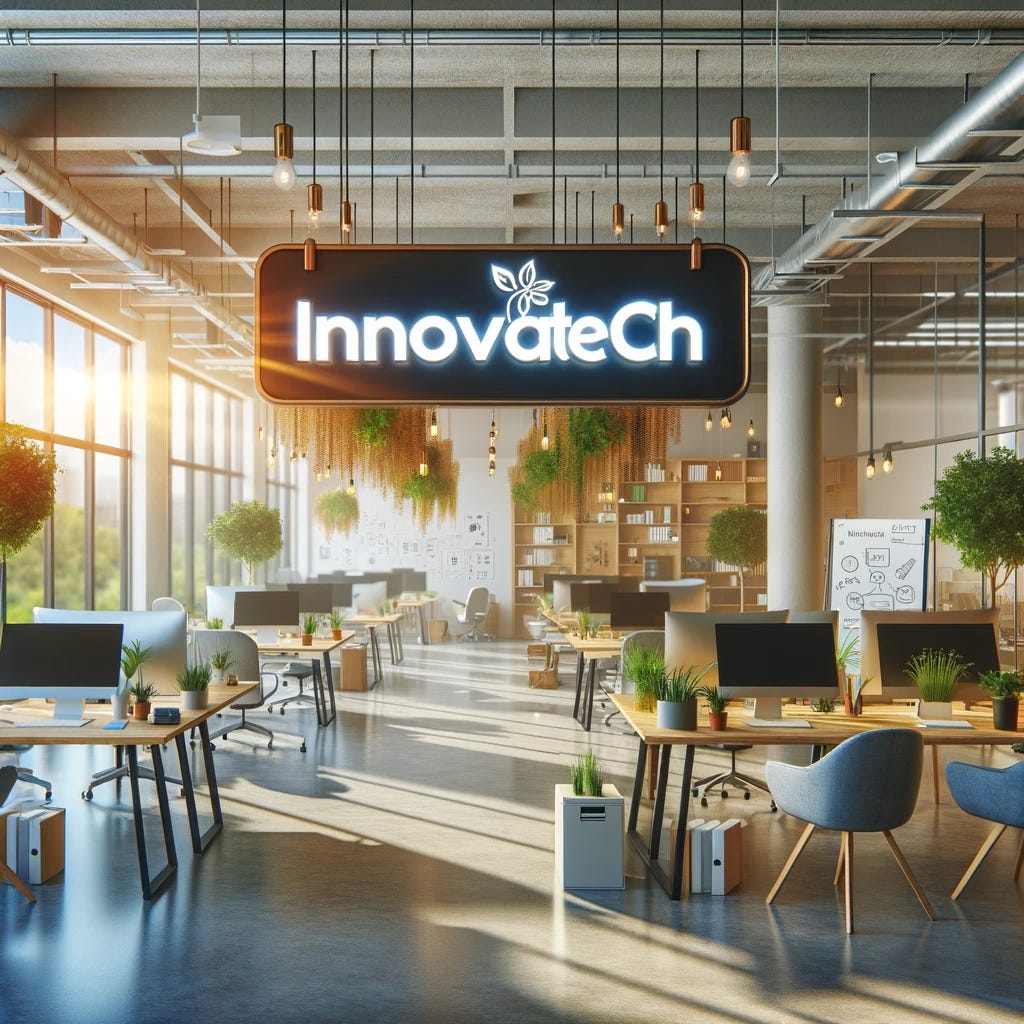From Hesitation to AI Innovation
A fictional -but very plausible- story about the journey of an HR Practitioner in embracing AI.
Preface
The following is NOT a true story.
I must confess: inspired by some feedback from my audience at a recent presentation, I used ChatGPT during a brainstorming walk this morning to help me write an engaging story about how an HR practitioner discovers and uses AI for employee onboarding. But it could easily be your story if you decide to start adopting AI in your workflow.
Meet Innovatech: A Fictional Tech Company
Innovatech is a forward-thinking technology company known for its innovative solutions and inclusive culture. The company specializes in developing cutting-edge software that transforms industries, from healthcare to finance. Innovatech prides itself on fostering a collaborative environment where creativity and teamwork are highly valued. With a diverse team spread across the globe, Innovatech is a place where employees can grow, learn, and make a real impact.
Meet Sarah, the HR Manager at Innovatech
Sarah, the HR Manager at Innovatech, is a passionate advocate for employee well-being and development. With over a decade of experience in human resources, she has a knack for making people feel valued and integrated. Outside of work, Sarah is an avid reader, a yoga enthusiast, and has a penchant for baking – her cookies are famous in the office.
Discovering GPT: A New Frontier
Sarah has been hearing about Artificial Intelligence and ChatGPT in the news but never thought that her role in HR would have much use for it. The idea of integrating AI into her daily tasks seemed far-fetched until she attended an HR tech event. There, a speaker shared how AI could revolutionize HR processes, including onboarding. Intrigued but overwhelmed by the possibilities, Sarah also felt a bit anxious about the future impact of AI on the workplace. However, she decided that fear was not useful; she needed to learn more.
Determined to stay ahead, Sarah went to OpenAI’s website and created a personal ChatGPT account to experiment. After a few successful trials, she gained confidence and sought approval from her supervisor to get a ChatGPT paid subscription. With the green light, she was ready to integrate this powerful tool into her workflow.
Pre-boarding with a Personal Touch
A new hire, James, is joining Innovatech as a software engineer. James is a recent graduate from a top engineering school, known for his innovative projects and keen problem-solving skills. He has a background in machine learning and is excited to apply his knowledge in a real-world setting. Outside of work, James is a gamer and a budding musician, always up for a challenge and eager to learn.
Sarah wants to make sure James feels welcomed even before his first day. She opens ChatGPT and types her first prompt:
"Create a personalized welcome email for James, who is joining our company as a software engineer. Include an introduction to the team members, an overview of the company’s mission and values, and a brief initial schedule. Highlight James’s background, skills, and interests. The tone should be friendly."
Within moments, ChatGPT generates a warm and detailed welcome email. Sarah quickly sends it off, ensuring no confidential information is shared in the prompts to maintain privacy and security. Sarah also learned that she can opt out of her data being used for training the models, so she makes sure to adjust that setting as well. James is thrilled with the result – he even jokes that the email makes him feel like he is joining Hogwarts rather than a tech company. Sarah chuckles, imagining James donning a wizard’s hat.
First Day: Making It Special
When James’s first day arrives, Sarah wants to ensure he receives a special welcome message from his manager, Tom. Tom is an experienced software engineer who has been with Innovatech for over eight years. Known for his leadership skills and calm demeanor, Tom has a reputation for being a supportive and approachable manager. Outside of work, Tom is an amateur chef and loves experimenting with new recipes.
Sarah turns to ChatGPT again, reflecting on her own first day at Innovatech and how a personal touch made all the difference. She types:
"Generate a personalized welcome message from Tom to James, who is starting as a software engineer. Include Tom’s background, the team’s goals and objectives, and an overview of initial projects or responsibilities. Mention James’s previous experience, skills, and expertise. The tone should be motivating."
The result is a heartfelt message that Tom is happy to deliver, after some tweaking and personalization. James feels an immediate connection to his new team and understands what to expect from his role. Tom’s message is so uplifting that James jokes he feels ready to tackle the world – or at least debug some really tough code. Sarah smiles, remembering her own early days of learning to code and the satisfaction of solving tricky problems.
First Week: Engaging Training
Sarah knows that training is a critical component of onboarding. She wants James to have an engaging learning experience. Reflecting on her own journey of continuous learning, she uses ChatGPT to create interactive training modules:
"Create engaging training content for James, who is starting as a software engineer. Include modules on Introduction to Company Systems, Best Coding Practices, and Project Management Tools. Outline key learning objectives for each module and suggest an interactive format such as videos, quizzes, or reading materials. Emphasize specific topics like company coding standards and agile methodologies. The tone should be informative."
With the training content ready, James finds the learning process both enjoyable and educational. He quickly gets up to speed with Innovatech’s systems and practices. At the end of the week, James jokes that he feels like he has just completed a marathon – but a fun one where you learn how to sprint in code. Sarah can relate; she has always enjoyed the blend of challenge and achievement in her own professional development.
Experiments and Learning Lessons
Sarah is getting used to it and now loves to experiment with new ideas to keep things fresh and engaging. One day, she decides to use an augmented reality (AR) app for an interactive office tour. She thinks it will be a hit, but James ends up getting a bit dizzy navigating through virtual hallways. They both laugh it off, and Sarah learns that sometimes simpler is better.
Another time, Sarah tries a digital scavenger hunt to familiarize James with key systems and tools. This one turns out to be a success. James has a blast, and even uncovers a hidden Easter egg that rewards him with a coffee gift card. Sarah notes this down as a win and plans to use it for future hires.
Conclusion: A New Thought Leader
By leveraging AI, Sarah enhances the onboarding experience for James significantly. She saves time on creating personalized communication and training materials, ensures a smooth integration for James, and gathers crucial feedback to keep improving the process. This approach not only boosts her productivity but also makes James feel valued and well-prepared to start his journey at Innovatech. As James often says with a grin, “If only all life transitions were this smooth, I’d be unstoppable.”
Sarah’s innovative approach doesn't go unnoticed. Her manager compliments her on her forward-thinking strategies, and soon other departments start asking for her advice on implementing AI in their processes. Sarah becomes a thought leader within her department and the organization, showing that with a bit of courage and curiosity, new technologies can transform traditional workflows for the better.
As Innovatech continues to grow, Sarah knows she has found a valuable ally in AI to help her create a welcoming and efficient onboarding process. And with each new hire, she feels more confident in her ability to blend technology with the human touch that defines her approach to HR.
A Closing Note on Implementation From the Human Co-Author
I tried to keep the story as introductory and non-technical as possible so that it is accessible to even someone who is just now mustering enough courage to go and play with AI.
The prompts I included in the story were only for illustrative purposes. They can be made much better, and they should be customized to the specific needs. My suggestion would be to try to leverage whatever information you already have available, so that you don’t have to rewrite everything when creating the prompt.
For example: the new employee’s resume, the job description of the position they are taking, your company Mission, Vision and Values document, etc
How to use it?: You can provide the resume of the new employee (or even better an anonymized version of it) to ChatGPT so that it can create an email introducing the new team member. Or you can provide the resume of the new employee and the job description for the position they are taking to generate ideas for a development plan that covers everything that they need to learn to do their job. And you can ask the LLM to take into account your Mission, Vision, and Values document so that it can utilize the same tone and anchor the output to your company’s language and culture.
Your journey is going to be from effectiveness to efficiency. You need to first make sure you’re getting things done effectively, ensuring valid outputs. And then rapidly iterate to make it more efficient:
can you use some kind of prompt template for more consistent results?
can you adjust your custom instructions so that they can be taken into account for every request you make?
can you create your own custom GPTs for requests you make frequently?
can you use some kind of Retrieval Augmented Generation (RAG) technique to help finetune the results?
can you sharpen your prompt engineering skills? (the link refers to Claude, which is one of the other LLMs available, but the principles apply in essentially the same way to ChatGPT)









